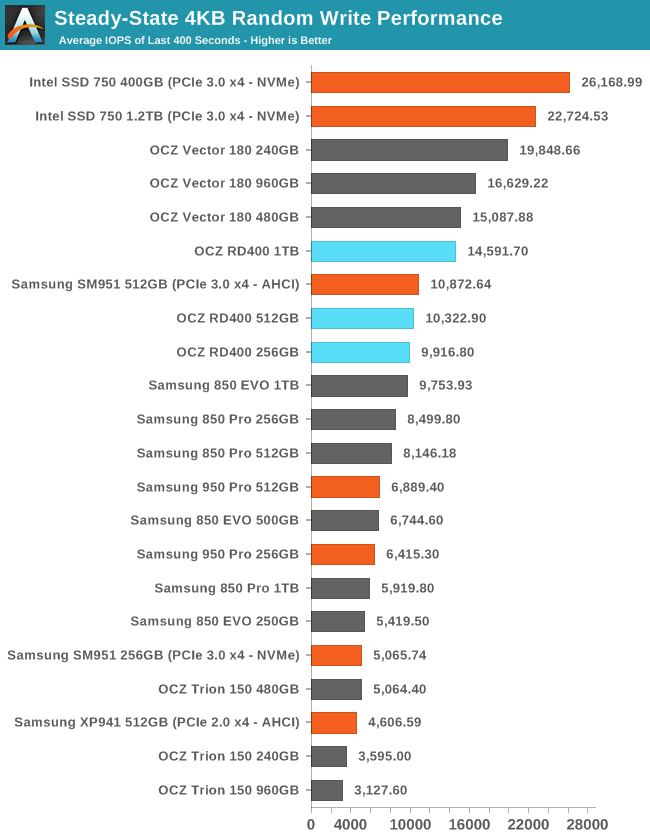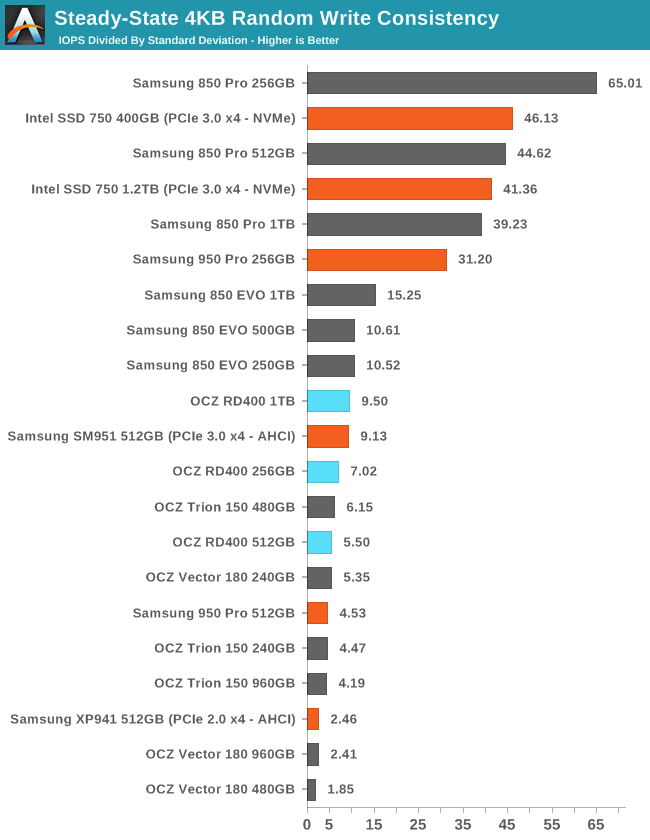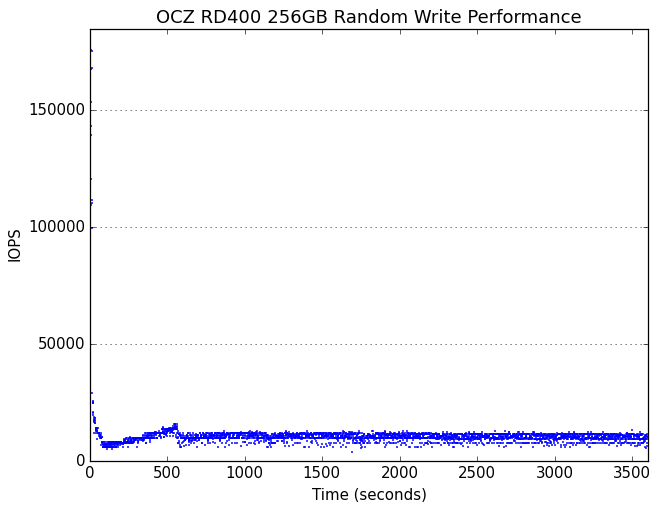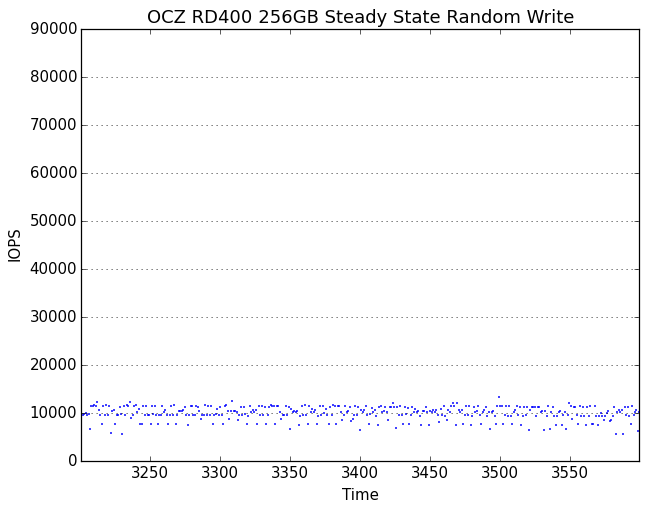The Toshiba OCZ RD400 (256GB, 512GB, 1TB) M.2 PCIe SSD Review
by Billy Tallis on May 25, 2016 8:02 AM ESTPerformance Consistency
Our performance consistency test explores the extent to which a drive can reliably sustain performance during a long-duration random write test. Specifications for consumer drives typically list peak performance numbers only attainable in ideal conditions. The performance in a worst-case scenario can be drastically different as over the course of a long test drives can run out of spare area, have to start performing garbage collection, and sometimes even reach power or thermal limits.
In addition to an overall decline in performance, a long test can show patterns in how performance varies on shorter timescales. Some drives will exhibit very little variance in performance from second to second, while others will show massive drops in performance during each garbage collection cycle but otherwise maintain good performance, and others show constantly wide variance. If a drive periodically slows to hard drive levels of performance, it may feel slow to use even if its overall average performance is very high.
To maximally stress the drive's controller and force it to perform garbage collection and wear leveling, this test conducts 4kB random writes with a queue depth of 32. The drive is filled before the start of the test, and the test duration is one hour. Any spare area will be exhausted early in the test and by the end of the hour even the largest drives with the most overprovisioning will have reached a steady state. We use the last 400 seconds of the test to score the drive both on steady-state average writes per second and on its performance divided by the standard deviation.

The RD400 sustains good random write performance, but the controllers and firmware in the OCZ Vector 180 and Intel 750 were designed with this kind of test in mind, and it shows. PCIe and NVMe don't help appreciably when the performance bottleneck is all the bookkeeping inside the controller, but NVMe controllers tend to have at least adequate processing power.

Most Samsung and Intel drives are much more consistent than the RD400, but the latter's score is fine for a client drive.
 |
|||||||||
| Default | |||||||||
| 25% Over-Provisioning | |||||||||
The 512GB RD400 shows oddly different behavior from the other two capacities when tested with overprovisioning, but the RD400 results are all good looking with no extremely low performance outliers.
 |
|||||||||
| Default | |||||||||
| 25% Over-Provisioning | |||||||||
The minimum random write performance of the RD400 is as good as the average performance of most SATA drives. There is some periodic variation apparent for the 512GB and 1TB models in the form of steep drops that last only a few seconds.










40 Comments
View All Comments
tarqsharq - Wednesday, May 25, 2016 - link
Interesting article as always. I had been hoping for a larger price gap between this and the Samsung 950 Pro. At current prices, I think the choice is fairly obvious unless you need a 1TB SSD.Chaitanya - Wednesday, May 25, 2016 - link
You have a choice of Sandisk X400 as well if you want 1TB capacity in M.2 form factor.edzieba - Wednesday, May 25, 2016 - link
There's also the OEM version of the OCZ drive, the Toshiba XG3, which is also available in a 1TB m.2 SKU.Lord of the Bored - Thursday, May 26, 2016 - link
And who DOESN'T need a 1TB SSD?MrSpadge - Friday, May 27, 2016 - link
I think you're mixing up "want" and "need".DanNeely - Wednesday, May 25, 2016 - link
"Unlike most cheap adapter cards, the RD400's adapter draws power from the PCIe slot's 12V supply and converts it to the 3.3V required by the M.2 drive."PCIe slots provide 10W of 3.3V power directly. (I believe this was originally done to make converting legacy cards via a bridge chip easier.) Why would the card need to do any DC-DC conversion?
Byrn - Wednesday, May 25, 2016 - link
I'd assume that if they convert they can get cleaner 3.3V than if they use the feed through the PCIe slot, or that they can design in better resilience to sudden power demand changes...Basically, by converting I would have thought they can better fit the power supplied to the drive to the demands it makes.
digitalgriffin - Wednesday, May 25, 2016 - link
You can filter any volt feed with enough capacitors. But you lose power efficiency when you do.Alexvrb - Wednesday, May 25, 2016 - link
Yeah but they're filtering the power either way so converting from 12V -> 3.3V is less efficient than using 3.3V to start with. But getting back to what Byrn was saying... Byrn, they don't have a choice: This drive draws too much power to use the 3.3V supply.Look at idle power figures in this article. ~2.5W @ 12V. At 3.3V that would already be pushing it (right around 9W already). Under a load it's going to draw too much. So they had to use the 12V rail.
Wardrop - Wednesday, May 25, 2016 - link
2.5 watts is 2.5 watts. If it's a higher voltage, it's less amps, and vice versa. I think you've confused watts with amps?